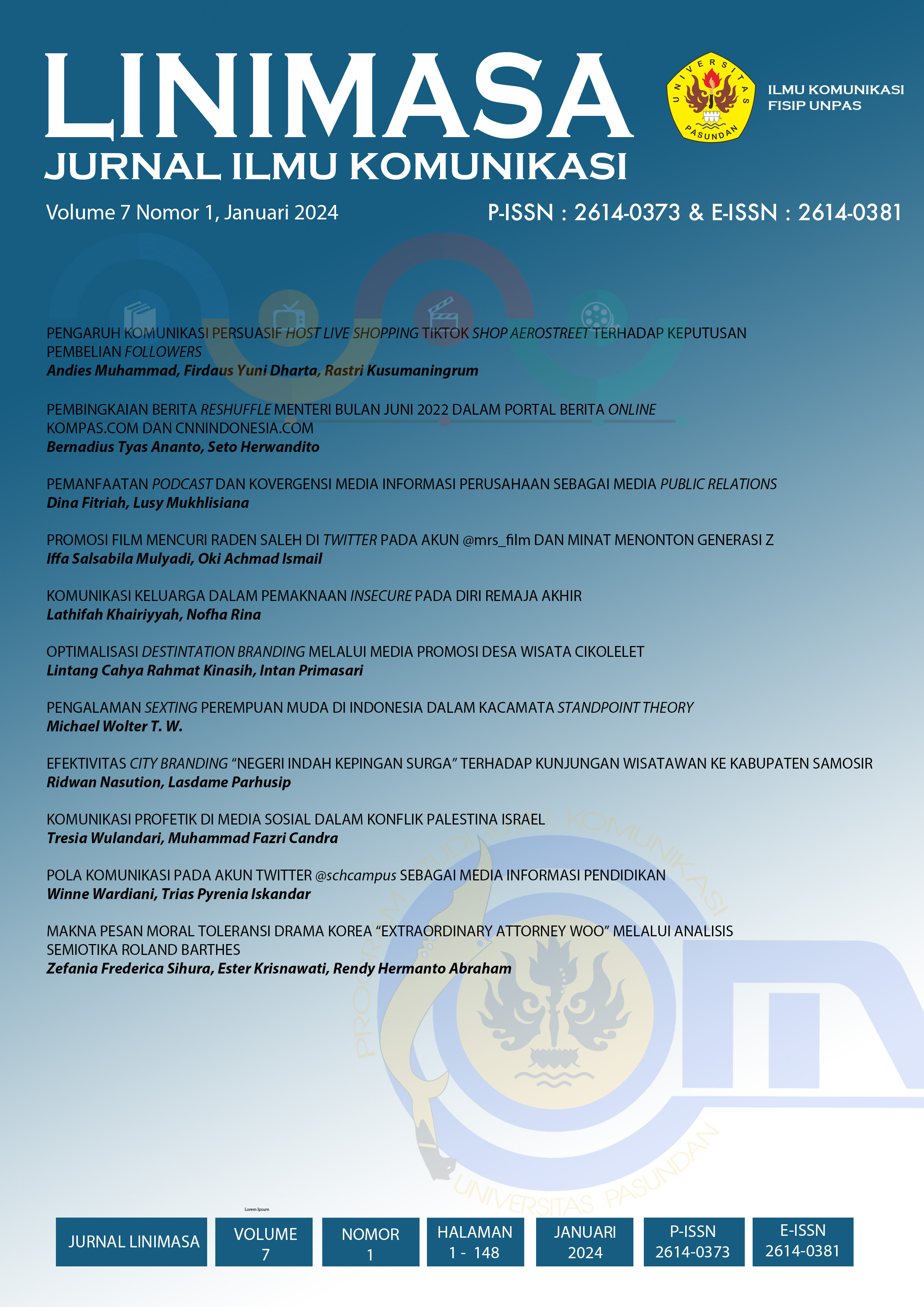PENGALAMAN SEXTING PEREMPUAN MUDA DI INDONESIA DALAM KACAMATA STANDPOINT THEORY
DOI:
https://doi.org/10.23969/linimasa.v7i1.10619Keywords:
Sexting, Standpoint Theory, Perempuan, DominasiAbstract
ABSTRACT
Sexting is the activity of sending sexually charged messages, whether in the form of photos, videos, or even short messages, carried out via digital media. Sexting activities are usually carried out by male and female couples who are in a romantic relationship. In this context, sexting is done to maintain the quality of the relationship and fulfill the partner's sexual needs. However, there is an imbalance of power between women and men involved in sexting, where women are vulnerable to finding themselves in a disadvantageous position compared to men. Through the perspective of standpoint theory, the experience of women as a marginalized group in sexting activities is an important experience to explore. In standpoint theory, those in marginalized positions are considered to have strong objectivity, so the search for knowledge according to this theory should start from these marginalized groups. Through in-depth interviews with informants, this research found that women are in an inferior position when sexting with men. The informants' experiences showed that male partners were forced to engage in sexting, threatened with sharing sexting content, threatened with the end of the relationship, and felt that sexting was more beneficial for men than women. This research concludes that through the lens of standpoint theory, women do feel injustice in sexting activities with male partners, but still do it in order to maintain their relationship through coercion and avoid bad consequences such as the distribution of sexts.
Keywords : Sexting; Standpoint Theory; Women; Domination
Downloads
References
Anastassiou, A. (2017). Sexting and Young People: A Review of the Qualitative Literature. The Qualitative Report. https://doi.org/10.46743/2160-3715/2017.2951
Chwaszcz, J., & Palacz-Chrisidis, A. (Eds.). (2014). Behavioral addictions. Natanaleum Association Institute for Psychoprevention and Psychotherapy.
Dainton, M., & Zelley, E. D. (2019). Individual and Social Approaches to Communication (4th ed.). SAGE Publications, Inc.
Fatwasuci, K., & Irwansyah, I. (2022). Fenomena Keberadaan Kaum Marginal dalam Masyarakat: Sebuah Kajian Literatur Standpoint Theory. JURNAL LENSA MUTIARA KOMUNIKASI, 6(1), 40–49. https://doi.org/10.51544/jlmk.v6i1.1669
Graham Holmes, L., Nilssen, A. R., Cann, D., & Strassberg, D. S. (2021). A sex-positive mixed methods approach to sexting experiences among college students. Computers in Human Behavior, 115, 106619. https://doi.org/10.1016/j.chb.2020.106619
Griffin, E., Ledbetter, A., & Sparks, G. (2018). Standpoint Theory. In A First Look at Communication Theory (10th ed., pp. 396–408). McGraw-Hill Education.
Halpern, M. (2019). Feminist standpoint theory and science communication. Journal of Science Communication, 18(04), C02. https://doi.org/10.22323/2.18040302
Holla, K., Jedlickova, P., & Seidler, P. (2019). Sexting and Motives for Sexting Among Adolescents. Journal of Interdisciplinary Research, 8(2). https://www.researchgate.net/publication/330324072_SEXTING_AND_MOTIVES_FOR_SEXTING_AMONG_ADOLESCENTS
Hudson, H. K., & Marshall, S. A. (2016). Sexty Southerners: Sexting content and behaviors among selected southern undergraduates. The Health Educator, 48(1), 34–43.
Huirem, R., Lognathan, K., & Patowari, P. (2020). Feminist standpoint theory and its importance in feminist research. Journal of Social Work Education and Practice, 5(2), 46–55.
Littlejohn, S. W., Foss, K. A., & Oetzel, J. G. (2017). The Communicator. In Theories of Human Communication (11th ed., pp. 51–100). Waveland Press, Inc.
Makondora, J., & Maunganidze, L. (2018). The Lived Experiences of Youths Involved in Sexting in the Greendale Suburb of Harare. International Journal of Law, Humanities, and Social Science, 2(6), 73–85.
Naples, N. A. (Ed.). (2016). The Blackwell encyclopedia of gender and sexuality studies. Wiley Blackwell.
Oriza, I. I. D., & Hanipraja, M. A. (2020). Sexting and Sexual Satisfaction on Young Adults in Romantic Relationship. Psychological Research on Urban Society, 3(1), 30. https://doi.org/10.7454/proust.v3i1.61
Paskah, V. (2016). Konstruksi Seksualitas Perempuan dalam Sexting [Universitas Diponegoro]. https://ejournal3.undip.ac.id/index.php/interaksi-online/article/view/14600/14124
Perry, K., Ricciardelli, R., & Adorjan, M. (2022). The Gendered Dynamics of Sexting as Boundary Work. YOUNG, 30(4), 400–418. https://doi.org/10.1177/11033088221076615
Reyns, B. W., Burek, M. W., Henson, B., & Fisher, B. S. (2013). The unintended consequences of digital technology: Exploring the relationship between sexting and cybervictimization. Journal of Crime and Justice, 36(1), 1–17. https://doi.org/10.1080/0735648X.2011.641816
Scholes-Balog, K., Francke, N., & Hemphill, S. (2016). Relationships Between Sexting, Self-Esteem, and Sensation Seeking Among Australian Young Adults. Sexualization, Media, & Society, 2(2), 237462381562779. https://doi.org/10.1177/2374623815627790
Setty, E. (2020). ‘Confident’ and ‘hot’ or ‘desperate’ and ‘cowardly’? Meanings of young men’s sexting practices in youth sexting culture. Journal of Youth Studies, 23(5), 561–577. https://doi.org/10.1080/13676261.2019.1635681
Van Ouytsel, J., Punyanunt-Carter, N. M., Walrave, M., & Ponnet, K. (2020). Sexting within young adults’ dating and romantic relationships. Current Opinion in Psychology, 36, 55–59. https://doi.org/10.1016/j.copsyc.2020.04.007
Weisskirch, R. S., & Delevi, R. (2011). “Sexting” and adult romantic attachment. Computers in Human Behavior, 27(5), 1697–1701. https://doi.org/10.1016/j.chb.2011.02.008
Winkelman, S. B., Vail-Smith, K., Brinkley, J., & Knox, D. (2014). Sexting on the College Campus. Electronic Journal of Human Sexuality, 17.















